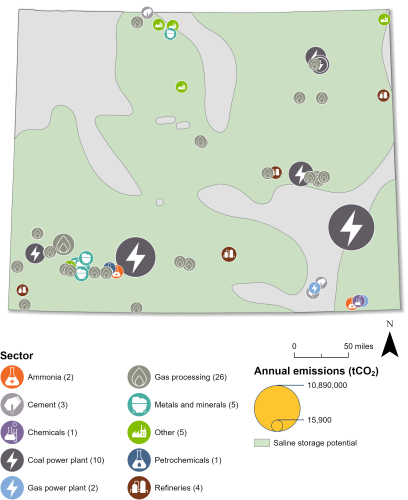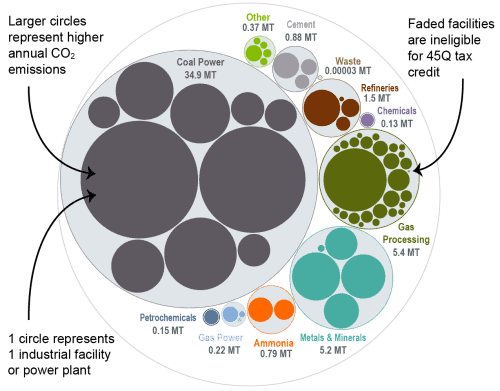Wyoming Carbon Capture Opportunities

Carbon capture can lower emissions across a variety of sectors in Wyoming and bring jobs and private investment to the state. Of the 64 industrial and power facilities in the state, 59 are eligible for the 45Q federal tax credit. These 59 facilities emit around 49 million metric tons of carbon dioxide (CO2) annually, representing over 99 percent of total annual CO2 emissions in the state.
Wyoming has a strong and comprehensive legislative framework for carbon management. The state has addressed key issues like pore space ownership, long-term liability, CO2 ownership, and unitization, and has a supportive tax structure and incentives for project developers. Furthermore, Wyoming is one of four states with Class VI primacy (alongside North Dakota, Louisiana, and West Virginia), making it well-positioned for continued project deployment.

Industrial and Power Facilities in Wyoming
Fifty-nine of Wyoming’s 64 industrial and power facilities (or 92 percent of facilities) are eligible for 45Q. As such, the state has significant potential to lower its total emissions with carbon management technologies. The state’s ten coal power plants, which account for the highest proportion of CO2 emissions, are all 45Q-eligible (it should be noted that one of these plants is set to retire all units in 2027). Additionally, Wyoming has a significant gas processing industry, with 26 eligible facilities. The state also has five metals and minerals facilities, four refineries, three cement facilities, two gas power plants, and nine other facilities that are 45Q-eligible. In total, emissions from these 59 eligible facilities represent 99 percent of Wyoming’s total annual CO2 emissions.
Beyond capture, Wyoming can safely store CO2 underground in geologic formations and has had Class VI primacy since 2020. The Wyoming Department of Environmental Quality granted its first three Class VI permits in 2023 and currently has one permit under review. The state is also well-positioned as a corridor for transporting CO2 regionally, as the home of a unique pipeline corridor initiative.

Sources: EPA GHGRP, 2024. Bauer et al., NATCARB, 2018.
Legislative Context for Carbon Management
The Wyoming government has demonstrated strong support for carbon management. Through participation in collaborative regional initiatives, state-level legislation, and support for federal legislation, the state has positioned itself well for project deployment. Wyoming’s statutory framework also serves as an example for other states crafting carbon management legislation:
- HB 89 (2008): Establishes that pore space is owned by surface owner. Pore space can be transferred as separate property.
- HB 90 (2008): Directs the Department of Environmental Quality to regulate and issue carbon storage permits under the current Underground Injection Control program.
- HB 57 (2009): Establishes the dominance of mineral rights over pore space.
- HB 58 (2009): Establishes that the site operator owns and is responsible for injected CO2 until liability is transferred to the state.
- HB 80 (2009): Establishes that at least 80 percent of pore space ownership within the proposed unit area must consent to the unitization plan for it to proceed.
- HB 17 (2010: Establishes the Geologic Sequestration Special Revenue Account to measure, monitor, and verify sites after closure and termination of permit. Fees are paid by permit holders of the site.
- SF 47 (2022): Provides for the transfer of long-term stewardship and liability of CO2, injected into geologic storage sites to the state after 20 years post-injection activity.
Most recently, Wyoming enacted legislation (SF 0017) establishing a stimulus for enhanced oil recovery operations for providers using carbon capture, utilization, and storage technologies. Several additional carbon management related bills were introduced in the 2025 legislative session, but did not pass before session adjourned. To see more details of these bills, view our State Legislative Tracker.
This bubble diagram shows the number of facilities and corresponding annual CO2 emissions for each industry in Wyoming. The darker bubbles are eligible for the 45Q carbon capture tax credit, while the faded bubbles are too small to be eligible. The total amount of CO2 emissions in Wyoming is listed for each industry in million metric tons.

Source: EPA GHGRP, 2024.
Last updated: June 2025

